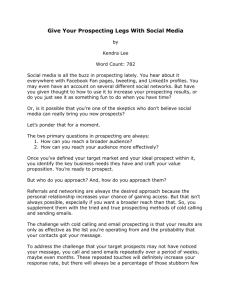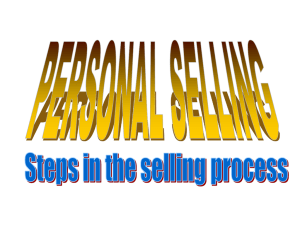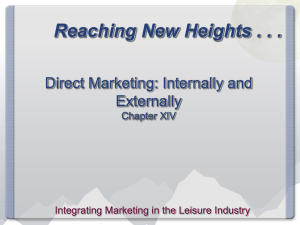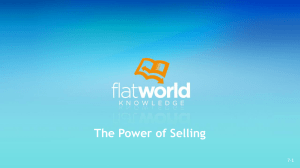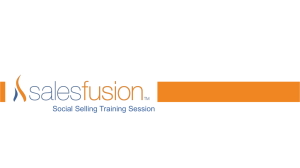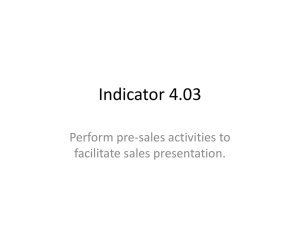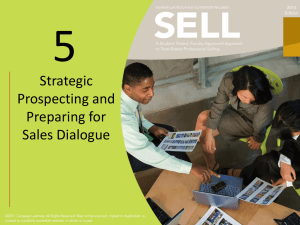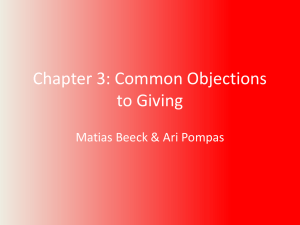Sales Skills Training - Name
advertisement
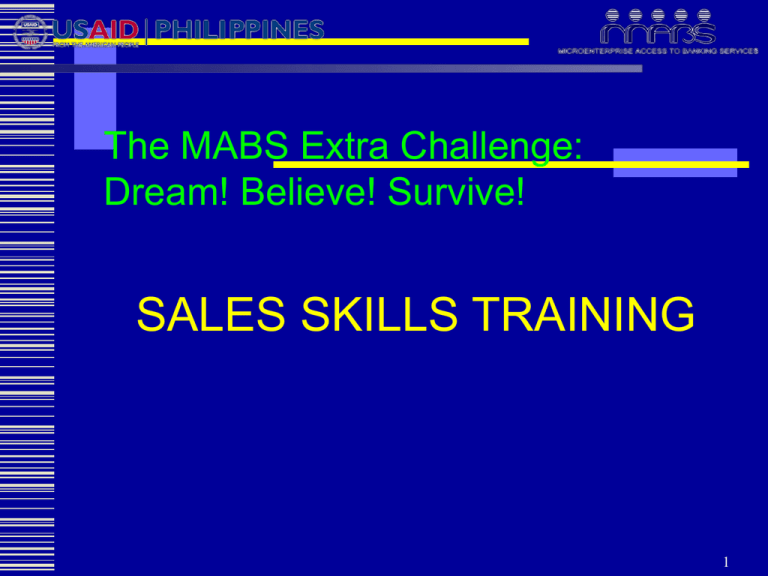
The MABS Extra Challenge: Dream! Believe! Survive! SALES SKILLS TRAINING 1 What’s in it for me? Why is it important for me to learn about selling skills? What would I gain from learning and employing selling skills? 2 What’s in it for me? Ensure professional and systematic approach to your work as an account officer Improve delivery of your performance targets Produce clients that are satisfied Generate more income for the bank and thereby, increase your chances of having better salaries and benefits 3 Outline Knowing Your Sales Cycle From Suspects to Prospects Win your Clients by Benefits Selling Handling Objections Closing the Sale Asking for a Referral 4 Typical Sales Cycle 1 Prospecting 7 2 Referral Sales Interview 6 3 Demonstration/ Transaction Proposal/ Closure Presentation 5 Negotiate 4 Substantiate 5 Sales Cycle The term given to a series of sequential steps that comprise a sales process. It consists of several logical steps that a sales person(the account officer) has to do from beginning to end of the cycle. Individually, each step within the sales cycle is called a stage. 6 Sales Cycle Each sales cycle stage has two basic components: 1) the predominant activity and 2) the compression objective. The predominant activity is the basic task the account officer needs to perform within each stage of the sales cycle. The compression objective is the primary focus of each stage of the sales cycle. This refers to what desired action the account officer would like the customer to make to move the sale to the next stage. 7 Typical Sales Cycle Stages Predominant Activity Prospecting Determine who are suspects and who are prospects Sales Interview Fact & emotion finding about your prospects Demonstration/Presentation Present and reinforce the benefits of certain features of your product Substantiate Establish credibility which gives your customers confidence and comfort in purchasing your product Negotiate Keep the negotiations going until sale is close Transaction Closure Get the commitment of the customer Referral Gather other leads 8 The Sales Cycle for a Microenterprise Loan Product 1 Prospecting 2 7 Client Orientation Ask for a Referral 3 6 CIBI/Cash Flow Analysis Loan Disbursement 5 Present Loan Package & Close transaction with Customer 4 Credit Committee 9 Exercise: Knowing your MF Loan Product Sales Cycle Stages Sales Cycle Stage Predominant Activity Compression Objective 1. Prospecting 2. Client Orientation 3. CIBI 4. Credit Committee 5. Negotiation/Close sale 6. Loan Disbursement 7. Referral 10 PROSPECTING “From Suspects to prospects” 11 PROSPECTING The first stage or beginning of the sales cycle. The predominant activity here is to determine who are the prospective clients and getting as much information as possible about them. 12 PROSPECTING 3 important elements present in a qualified prospect: 1. The authority to make a buying decision. 2. Control over the budget. 3. A need or want for your service or product. If one of these elements are missing, then what you have is just a suspect. 13 Prospecting Steps in identifying potential customers Leads Individuals who possibly fit your loan product’s client eligibility criteria. Prospects Those that have already an interest in the product Qualified Prospects Those that want the product, can afford to buy it and have the authority to make the purchase decision. 14 Prospecting Techniques A. Existing Customers B. Former Customers C. Directories & Souvenir Programs D. Newspapers & Magazines E. Yellow Pages F. Seminars G. Networking H. Direct Mail / Advertising I. Public Relations J. Associations K. Cold Calls L. Referrals 15 Some things to remember about prospecting “It is a game of numbers” Know your ratios and strive to improve them Quality prospects Make every day a prospecting day 16 Weekly Prospecting List Form ABC LOAN PRODUCT WEEKLY PROSPECTING LIST Week 1 :January 5-9, 2004 1. New Accounts Market Segment: Wholesale & Retail Trade Sector Name of Business Address Projecte d Loan Amount Call Date Follow -up Date Remark s 1. 2. 3. 4. 5. Prepared and Submitted by: _______________________________________ Signature over Printed Name of Account Officer _______________________________________ Date of Submission *To be prepared in duplicate copies; 1 for the account officer 1 for the MF Supervisor 17 Benefits Selling “Benefits selling: the heart of a winning presentation” 18 When does selling take place? The client orientation is comparable to the sales presentation stage of a sales cycle. The predominant activity of this stage is to teach your customer the benefits of doing business with your bank. The objective here is to be able to sell the product’s benefits and support these with product features. 19 Selling Benefits: The heart of a winning presentation Buying Motive - The reason why a product user buys. - It is his/her motivation to buy and own a specific product. - The buying motive must always be the focus of the selling activity. A client will be motivated to “listen” if the discussion on the product will meet his/her objective in buying. 20 Selling Benefits: The heart of a winning presentation The Buying Market 1. Effectiveness 2. Supply 3. Convenience 4. Availability 5. Pride 6. Economy 21 Selling Benefits: The heart of a winning presentation FEATURES: An element of a product that delivers a benefit. It is the inherent characteristic of a product. It is the quality that makes it competitive with other lines. It always answers the question “what is it?” 22 Selling Benefits: The heart of a winning presentation BENEFITS: It is the performance of the product to promote the well being of the user. It answers the question “What can it do for me?” (WIFM) 23 Selling Benefits: The heart of a winning presentation Some examples: Feature Airbags Large type Digital recording Soft leather sneakers Mercedes Benz logo Benefit Lowered risk of serious injury Ease of reading Hiss-free listening More comfortable walking Increased self-esteem based on status 24 Selling Benefits: The heart of a winning presentation BENEFITS WRITING EXERCISE (Converting your loan product features into benefits) 25 Handling Objections “Overcoming objections in a Planned Manner” 26 Handling Objections Process: Step 1. Hear the full objections(listen before reacting) Step 2. Make an accurate diagnosis Step 3. Review the objection with the client Step 4. Answer with proof (whenever possible) Step 5. Seek agreement with the client that his objection has been answered and overcome 27 Handling Objections Methods in Handling Objections “YES-BUT” METHOD BOOMERANG METHOD QUESTION METHOD COUNTER BALANCED METHOD THIRD PARTY METHOD DIRECT DENIAL METHOD 28 Handling Objections 1. “YES-BUT” METHOD The account officer acknowledges understanding of why the prospect is making the objection and then shows the prospect why he does not have adequate information. 2. BOOMERANG METHOD The account officer using this method turns the objection into a reason for buying. 29 Handling Objections 3. QUESTION METHOD The account officer prods the prospect to answer his own objection by asking him a series of question. 4. COUNTER BALANCED METHOD The account officer uses this method when the prospect’s objection is valid and cannot be truthfully denied. However, it can be compensated for by some other overbalancing benefit. 30 Handling Objections 5. THIRD PARTY METHOD The account officer can answer a prospect’s objection by calling on the testimony of a third person. 6. DIRECT DENIAL METHOD The account officer uses this method when the prospect leaves you no other choice. If the salesperson has been generally pleasant and agreeable throughout the interview, his denial will be all the more convincing. 31 Closing the Sale Objective: To know when to close the sale When to close the sale (situations) When the client agrees to the answer to his objection When the client is sold on the benefit of the product When non-verbal signs show satisfaction with the product When the client offers a hidden benefit of the product When all sales resistance shown by the client is contained 32 Closing the Sale Step 1. Shoot a temperature question A temperature question will seek the real feelings of the client about a product proposal. The account officer has to review the benefits which can really convince the client to buy. In short, the client is sold or half-sold on the sales proposal. Step 2. Close the sale Step 3. Leave with a reminder 33 Closing the Sale Things to remember: 1. Closing is the name of the game. 2. Business requires new money coming in or it fails. Therefore, CLOSE MORE SALES. 3. Closing is sweet success. 4. A CHAMPION has the habit of closing sales most of the time. 34 Ask for a Referral Somewhat a new concept in looking at a sales cycle. Closing the sale is your PAYCHECK; a referral is your BONUS. A referral, especially coming from a good client, can be your number one prospecting tool. Referral actually shorten your sales cycle. 35
